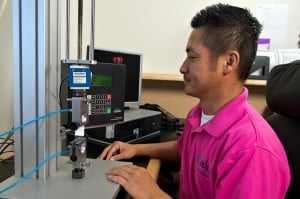 While commonly used methods to test for package strength and package integrity have been around for some time, there still seems to be some confusion in the medical device industry when it comes to the difference between testing the strength of a package versus the integrity of a package. The following blog posts aims to explain the differences between package strength and integrity, and the common tests used to determine each.
While commonly used methods to test for package strength and package integrity have been around for some time, there still seems to be some confusion in the medical device industry when it comes to the difference between testing the strength of a package versus the integrity of a package. The following blog posts aims to explain the differences between package strength and integrity, and the common tests used to determine each.
Package strength concerns the force required to separate two components of the package. In order to produce acceptable packages on a daily basis and throughout a determined shelf-life validation, it is important to evaluate the strength characteristic. Not only does the strength characteristic play a key role in a shelf-life validation, it lets manufacturers determine on a daily basis that their process for sealing packages is consistent with their predetermined specification set in the process validation. For instance, it could be the force to separate two flexible components of a pouch or a flexible lid and a thermoform tray. These forces may be measured in pounds per inch width, as in the seal/peel test, or in pounds per square inch, as in the burst-test method.
The main culprit for poor package strength is the sealing parameters. If a proper process validation of the sealer is not performed, the medical device manufacturer can expect failure. Some typical package-strength testing include: ASTM D3330, package strength testing by peel adhesion; ASTM F88, package strength testing by seal peel testing; and ASTM F-1140, package strength testing by burst testing.
Alone, these tests of package strength do not necessarily prove the integrity of the entire package. Package integrity testing is important in determining the sterility and the shelf life of a medical device or product. To maintain the sterility of an enclosed product until it reaches its point of end use, the packaging must provide a microbial barrier in the post-sterilization environment. The manufacturer must demonstrate that, under the rigors of distribution, storage, handling, and aging, sterile- package integrity is maintained at least for the claimed shelf life of the medical device. The microbial barrier properties of the package materials and design must be evaluated after exposure to the environmental and dynamic stresses expected for the finished package. Several methods may be used to satisfy these requirements. They involve evaluating the material performance itself and the whole, finished package as produced on the packaging line.
Packages may lose their integrity as a result of the dynamic-related events that occur during processing and distribution. Physical test methods may be used to validate that the package integrity has been maintained throughout the package’s processing, expected shelf life, and handling. Testing includes: ASTM F1929-98, package leak testing by dye penetration; ASTM F2096-02, package leak testing by bubble emission; and ASTM D3079-02 and ASTM D4991-94, package leak testing by vacuum.